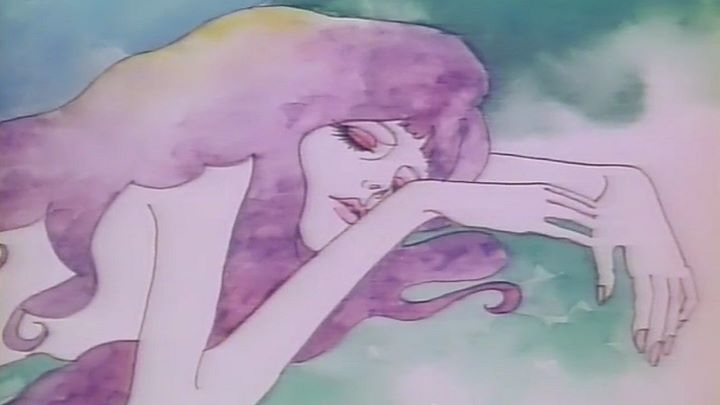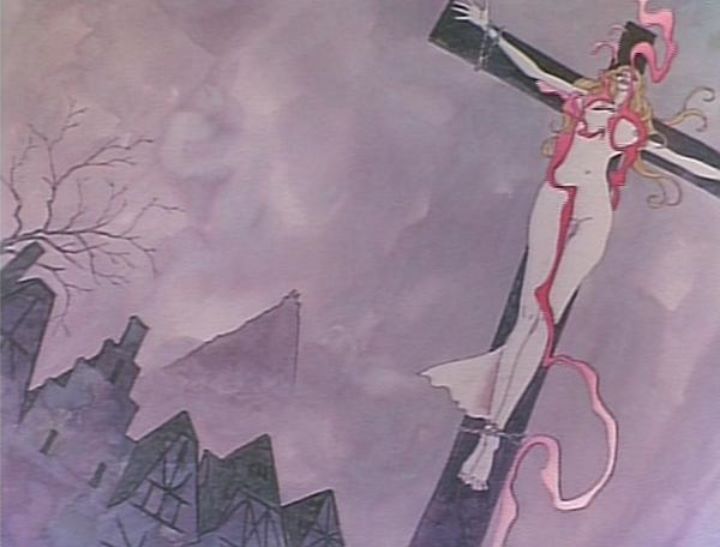






While not well-remembered, in the 1970's, there was a trilogy of anime films from Japan titled "Animerama." They took advantage of the trend of X-Rated films (more sex than usual a the time would be in such films), which were popular even in animation in America and around the world (although "Animerama" arguably pre-dates the trend). The series was founded by Osamu Tezuka, the legendary animator and manga artist that Japan's industry still ows to today. The films themselves vary in qualty: "A Thousand and One Nights" was a fun advanture adapting the story of Aladdin, "Cleopatra" was a surreal sexy take on the famous queen, and "Belladonna of Sadness" was a femenist retelling of the legend of Joanne of Arc. All the films were made on a tight budget, and so look a bit cheap even by anime standards, but the filmmakers were clever in how to get around this restriction. Anyway, the films were apparently released once on DVD in North America, but it was so long ago that the films are considered impossible to watch, less you try to watch poor-quality illegal copies online. Defying all odds, Cinelicious Pics was able to obtain the materials for a 4K restoration and theatrical/Bluray release in North America for one of the films, "Belladonna of Sadness," in 2016. The release was limited, and so the physical release is already lost, but I was fortunate to have bought a copy before it ran out, and thus was able to see the film in its best form.... while it is certainly a interesting part of animation history, and while the artists did the best they could with the resources available, "Belladonna of Sadness" doesn't really meet the high standards that the best animated features have since accomplished. It's more of a dated novelty than a classic. Which is not to say that it isn't worth watching, but perhaps it isn't worth the effort to seek out based on it being hard to find and / or expensive. At the start of the story, Jeanne and Jean have just gotten married in a medival town, and seem as happy as can be. That changes when the local baron comes to offer his best wishes to the couple, and per custom, to take Jeanne's virginity as per his right as the leader of the town (a practice that supposedly occurred in times long ago). Jeanne returns home, but is horrified by the experience, partly because of the act itself and because she and her husband were powerless to stand against it; Jean is a rather cowardly figure throughout the film. Jeanne in her despair is met by a small demon-like creature, introducing himself as the devil, and periodically provides her with power as she wishes. Jeanne and Jean's fortunes begin to change, gaining wealth and respect throughout the town (specifically for Jeanne, less so for the husband), until the heads of the state (including the baron) denounce her for witchcraft.The story from start to finish is a tragic one, but finds moments of humor and sexual empowerment. The devil, for example, is a wise and crafty character that initially takes a form that looks suspiciously phallac, nestling himself around Jeanne's fingers on their first meeting, and grows as the story progresses into a large mountain of domination. If I have any problem with the story, it comes partially from the format and the music. Believe it or not, this is almost a musical, with several slow ballads narrating the emotions of the characters as the story progresses. The music is beautiful in its own way, but the slow pacing feels deliberately dated.  As to the sex and psychedelic 70's-inspired imagery? Yes, sex is an important part of the story, and it is present such that only mature audiences should be watching, but many films and shows since (especially in anime) make this almost look tame by comparison. More fascinating is the use of metaphoric imagery to convey sex when it occurs, which is both imaginative and insightful for the powerful emotions in the moment. Generally, the art style is certainly unique, and one can find several pieces of art for the film that look absolutely breathtaking, enough so to warrant a gallery exhibit. But within the film itself, the majority of the art resembles the production values, cheap and quickly produced, and to be witness to a feature film using this style only further highlights its weaknesses. The animation is an oddity: there almost isn't any. It's the first animated film I've seen to mostly be told through still images. When animation does occur, it generally looks good (the devil character is particularly well-animated compared to the stiffness of the humans). Often, the picture is framed with surrounding black which moves during a shot to make you focus on a different scene, or to convey movement of a camera. This technique is not too different from practices in anime in the years that followed, and it allows a single painted image to be surprisingly engaging in a minute-long scene. The music and voice acting are the best highlight to take away from the film. Yes, the ballads are distracting, but beautful if listening quietly outside the film. While there is no English dub available, the Japanese voice-acting holds up well, which was important since they provide more character to the people than the non-existant animation. I can't help but wonder if the script would be well-suited for an adaptation on the stage rather than in film, even though it would be difficult to market a play featuring this much nudity and attracting the correct audience to appreciate the finer sublties.I suppose I was left slightly disappointed and impressed at the same time. I am certain that, if alive today and with the correct resources, the film would have been made very differently. But some of the techniques used and the pro-feminist plot are unique to the field. And since "Belladonna of Sadness" is generally the more memorable of the trilogy (I personally prefer "A Thousand and One Nights," but only barely), I don't think one will feel they are missing out much from the absence of easy viewing of the entire trilogy. But I would love to own a copy of all three anyway, if only for their historic value.
As to the sex and psychedelic 70's-inspired imagery? Yes, sex is an important part of the story, and it is present such that only mature audiences should be watching, but many films and shows since (especially in anime) make this almost look tame by comparison. More fascinating is the use of metaphoric imagery to convey sex when it occurs, which is both imaginative and insightful for the powerful emotions in the moment. Generally, the art style is certainly unique, and one can find several pieces of art for the film that look absolutely breathtaking, enough so to warrant a gallery exhibit. But within the film itself, the majority of the art resembles the production values, cheap and quickly produced, and to be witness to a feature film using this style only further highlights its weaknesses. The animation is an oddity: there almost isn't any. It's the first animated film I've seen to mostly be told through still images. When animation does occur, it generally looks good (the devil character is particularly well-animated compared to the stiffness of the humans). Often, the picture is framed with surrounding black which moves during a shot to make you focus on a different scene, or to convey movement of a camera. This technique is not too different from practices in anime in the years that followed, and it allows a single painted image to be surprisingly engaging in a minute-long scene. The music and voice acting are the best highlight to take away from the film. Yes, the ballads are distracting, but beautful if listening quietly outside the film. While there is no English dub available, the Japanese voice-acting holds up well, which was important since they provide more character to the people than the non-existant animation. I can't help but wonder if the script would be well-suited for an adaptation on the stage rather than in film, even though it would be difficult to market a play featuring this much nudity and attracting the correct audience to appreciate the finer sublties.I suppose I was left slightly disappointed and impressed at the same time. I am certain that, if alive today and with the correct resources, the film would have been made very differently. But some of the techniques used and the pro-feminist plot are unique to the field. And since "Belladonna of Sadness" is generally the more memorable of the trilogy (I personally prefer "A Thousand and One Nights," but only barely), I don't think one will feel they are missing out much from the absence of easy viewing of the entire trilogy. But I would love to own a copy of all three anyway, if only for their historic value.